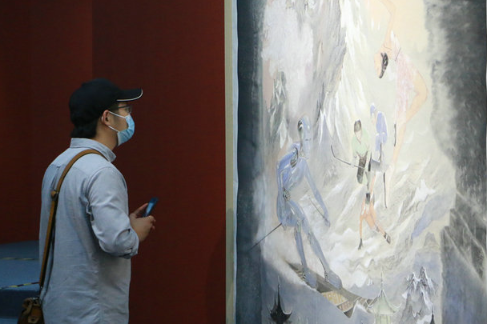


Gao Made is a largely self-taught painter and was heavily influenced by the cartoonist and guohua (“National Painting”) painter Ye Qianyu, an example of whose work can also be seen in the exhibition (EA1995.274). A similar promotion can be seen in the case of martial arts, the subject of the next instalment of this blog. Gao Made’s interpretation of “Stunned by the Transformation” – a scene from The Legend of the White Snake (Baishe zhuan 白蛇傳) – is a good example of his work and is part of trend particularly prevalent after the foundation of the PRC to paint scenes from Peking Opera with a view to displaying one of China’s national treasures to the world. Returning to the theme of Peking Opera as it appears in the Ashmolean exhibition. Gao Made, The Legend of the White Snake (Baishe zhuan 白蛇傳), 1990, Reyes Gift, EA1995.190 © the artist’s estate it has not changed its name to “Beijing University”), it should be seen as more correct to use the term “Peking Opera” when referring to jingju the term “Beijing Opera” being something of an anomaly, with the word “opera” used simply to refer to a form of sung drama. Peking Opera was, then, an English-language term used to refer to the Chinese art form known in Chinese as jingju and in much the same way that “Peking University” is still the official name of that university (i.e. The term “Peking Opera” is not a translation of the Chinese term jingju but was devised by English speakers in the nineteenth century to refer to this specific dramatic form. The type of sung drama to which this term refers is known in Chinese as jingju 京劇 (or sometimes jingxi 京戲), a term that might be best translated into English as “Drama of the Capital”.

Peking Opera version of the Red Detachment of Womenīefore going any further I feel it is important to say a word or two about the term “ Peking Opera”.

Following this came the Peking Opera version, which, to the fan of Peking Opera is equally impressive, if not quite so exciting for the lay viewer. The most famous version of this story is the ballet version, based on a 1961 film of the same name. In the previous instalment of the blog mention was made of the Red Detachment of Women. Three figures from the ballet version of Red Detachment of Women, 1970s, Gittings Gift, EA2008.36.c © Ashmolean Museum, University of Oxford


 0 kommentar(er)
0 kommentar(er)
